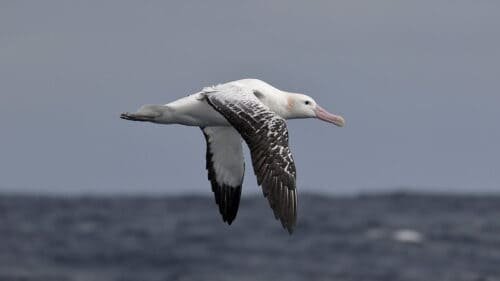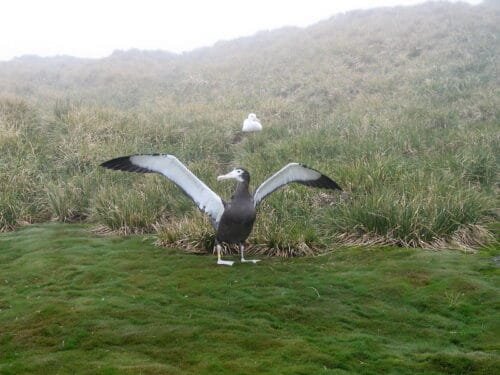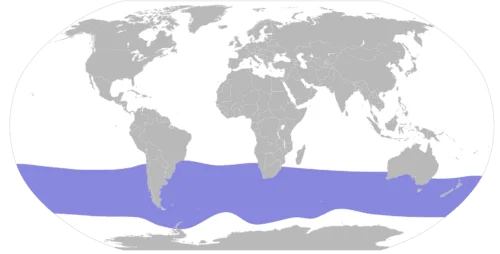The Wandering Albatross (Diomedea exulans) is the world’s largest seabird, recognized for its enormous wingspan and awe-inspiring oceanic journeys.
Welcome back to our nature blog, where we dive into the incredible world of wildlife with a light-hearted and informative touch. Today, we’re embarking on an adventure to learn more about the world’s largest seabird, the Wandering Albatross!
These magnificent birds are true oceanic explorers, known for their impressive wingspan and remarkable long-distance flights. Join us as we uncover the captivating life of these majestic avian giants and their fascinating lives on the high seas.

The Wandering Albatross (Diomedea exulans) holds the title of the world’s largest seabird, boasting an astounding wingspan that can reach up to 11 feet (3.5 meters) from tip to tip.
These impressive birds belong to the family Diomedeidae and are found primarily in the Southern Ocean, ranging from the sub-Antarctic to the Antarctic regions. With their predominantly white plumage and black accents on the wings, the Wandering Albatross is an unmistakable sight as it glides effortlessly across the open ocean.
Migrations
Wandering Albatrosses are renowned for their incredible oceanic journeys, spending most of their lives on the open sea, far away from land. They are exceptional fliers, known for their ability to travel vast distances with minimal effort, thanks to a technique called dynamic soaring.
This energy-efficient flight pattern enables them to glide on wind currents and air pressure differences without the need for constant flapping, allowing them to conserve energy and cover great distances.

Habitat and Distribution: Where to Find the World’s Largest Seabird
If you’re a birdwatcher or simply curious about the world’s largest seabird, you might be wondering where you can catch a glimpse of the Wandering Albatross. The best time to observe these awe-inspiring birds is during their breeding season, which typically occurs from November to March.
They can be found nesting on remote islands in the Southern Ocean, such as South Georgia, Crozet Islands, Kerguelen Islands, and the Prince Edward Islands.
To increase your chances of spotting these magnificent seabirds, consider joining a pelagic birdwatching trip or visiting a known breeding colony during the breeding season. Remember to bring along a good pair of binoculars and exercise patience, as these impressive birds can often be seen soaring high above the ocean’s surface or resting on the water between flights.

Diet and Hunting: The Largest Seabird in the World
The diet of the Wandering Albatross is quite diverse, including fish, squid, krill, and other marine creatures. These skilled hunters are known to scavenge from the ocean’s surface, as well as dive to depths of up to 16 feet (5 meters) in pursuit of prey.
They are also known to follow fishing vessels, opportunistically feeding on discarded fish and offal, which can sometimes lead to encounters with longline fishing gear.
Mating and Reproduction
Wandering Albatrosses have a unique breeding strategy, characterized by long-term monogamous pair bonds and infrequent breeding intervals.
They typically breed every two years, with both parents sharing the responsibility of incubating the single egg laid and caring for the chick once it hatches.
The nesting sites are usually located on remote, windswept islands in the Southern Ocean, providing ample space for these large seabirds to take off and land with ease.
Conservation Status
The Wandering Albatross is currently listed as vulnerable on the IUCN Red List, with populations facing threats such as habitat degradation, pollution, and bycatch in fishing gear.
Conservation efforts are crucial to ensuring the continued survival of these magnificent seabirds and the preservation of the marine ecosystems they inhabit. These efforts include implementing measures to reduce bycatch, such as bird-scaring devices and line-weighting on fishing vessels, as well as protecting breeding sites, monitoring populations, and raising awareness about the importance of conserving marine habitats and their unique biodiversity.
Fun Fact
Did you know that the Wandering Albatross possesses an unusual and fascinating method of communication? These seabirds have a specialized nasal gland that allows them to produce a strong, musky scent, which they use to identify one another and communicate within their breeding colonies.
This unique olfactory ability sets the Wandering Albatross apart from many other bird species and adds an extra layer of intrigue to their already captivating lives.
Conclusion
The Wandering Albatross, the world’s largest seabird, is a breathtaking and awe-inspiring example of the marvels of the natural world. With their enormous wingspan, incredible oceanic journeys, diverse diet, and fascinating communication abilities, these majestic birds never cease to amaze and inspire bird enthusiasts and nature lovers alike.
By continuing to learn about and protect the Wandering Albatross, we can help ensure their survival and the health of the marine ecosystems they call home. So, the next time you find yourself gazing out across the vast, open ocean, keep an eye out for these soaring giants – you might just be fortunate enough to witness the enchanting world of the Wandering Albatross!
